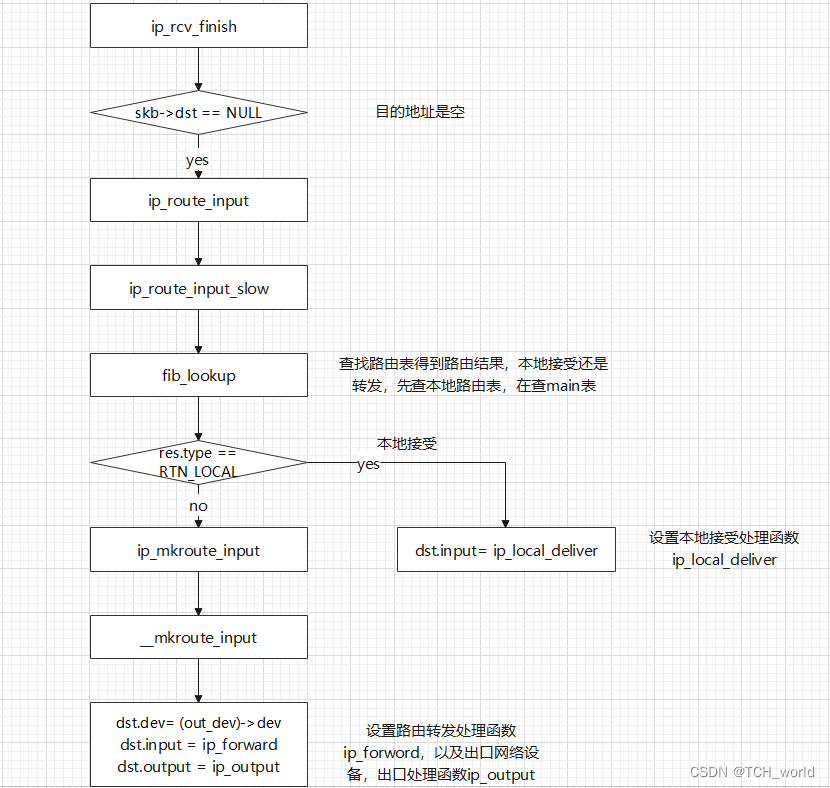1 ip_rcv_finish
ip_rcv这个函数主要是对数据包做各种正确性验证,然后调用掉网络过滤子系统的在PRE_ROUTEING链上的回调函数,经过网络子系统的处理在调用ip_rec_finish,ip_rcv_finish主要的工作:确定数据包是前送还是在本机协议栈上传,如果是前送要确保输出网络设备和下一个接受栈的地址。
我们看一下ip_rcv_finish的源码,首先判断skb->dst是否为NULL,如果是表明数据包的去向还没有定,那么需要调用ip_route_input决定数据包的去向
static int ip_rcv_finish(struct sk_buff *skb)
{
const struct iphdr *iph = ip_hdr(skb);
struct rtable *rt;
/*
* Initialise the virtual path cache for the packet. It describes
* how the packet travels inside Linux networking.
*/
if (skb->dst == NULL) { //目的地址是空
int err = ip_route_input(skb, iph->daddr, iph->saddr, iph->tos,
skb->dev);
}
.....
}ip_route_input函数主要是调用rt_hash根据目的地址得到路由哈希值,然后调用ip_route_input_slow继续进一步处理
int ip_route_input(struct sk_buff *skb, __be32 daddr, __be32 saddr,
u8 tos, struct net_device *dev)
{
struct rtable * rth;
unsigned hash;
.....
return ip_route_input_slow(skb, daddr, saddr, tos, dev); //下一步进行路由判断
}2 ip_route_input_slow
ip_route_inout_slow最重要的是调用fib_lookup根据目的地址查找路由表得到路由结果struct fib_result *res,决定数据包去向,如果res.type == RTN_LOCAL那么就是本地接受的数据,那么设置数据包下一步处理函数为ip_local_deliver,如果是转发数据包那么进一步调用ip_mkroute_input
static int ip_route_input_slow(struct sk_buff *skb, __be32 daddr, __be32 saddr,
u8 tos, struct net_device *dev)
{
struct fib_result res;
......
if ((err = fib_lookup(net, &fl, &res)) != 0) { //这个函数很重要,查询路由表,将路由结果保存在struct fib_result *res, 决定数据包的走向
if (!IN_DEV_FORWARD(in_dev))
goto e_hostunreach;
goto no_route;
}
......
if (res.type == RTN_LOCAL) { //本地接受的数据包,
int result;
result = fib_validate_source(saddr, daddr, tos,
net->loopback_dev->ifindex,
dev, &spec_dst, &itag);
if (result < 0)
goto martian_source;
if (result)
flags |= RTCF_DIRECTSRC;
spec_dst = daddr;
goto local_input;
}
......
err = ip_mkroute_input(skb, &res, &fl, in_dev, daddr, saddr, tos); //路由转发处理
brd_input:
if (skb->protocol != htons(ETH_P_IP))
goto e_inval;
if (ipv4_is_zeronet(saddr))
spec_dst = inet_select_addr(dev, 0, RT_SCOPE_LINK);
else {
err = fib_validate_source(saddr, 0, tos, 0, dev, &spec_dst,
&itag);
if (err < 0)
goto martian_source;
if (err)
flags |= RTCF_DIRECTSRC;
}
flags |= RTCF_BROADCAST;
res.type = RTN_BROADCAST;
RT_CACHE_STAT_INC(in_brd);
local_input: //本地接受处理,做一些初始化
rth = dst_alloc(&ipv4_dst_ops);
if (!rth)
rth->rt_iif =
rth->fl.iif = dev->ifindex;
rth->u.dst.dev = net->loopback_dev;
dev_hold(rth->u.dst.dev);
rth->idev = in_dev_get(rth->u.dst.dev);
rth->rt_gateway = daddr;
rth->rt_spec_dst= spec_dst;
rth->u.dst.input= ip_local_deliver; //设置本地结束处理函数
rth->rt_flags = flags|RTCF_LOCAL;
......
}2.1 fib_lookup
fib_lookup查询路由表,将路由结果保存在struct fib_result *res, 决定数据包的走向,先查找本地路由表,再查找main路由表
static inline int fib_lookup(struct net *net, const struct flowi *flp,
struct fib_result *res)
{
struct fib_table *table;
table = fib_get_table(net, RT_TABLE_LOCAL);
if (!table->tb_lookup(table, flp, res)) //先查找本地路由表
return 0;
table = fib_get_table(net, RT_TABLE_MAIN); //再查找main路由表
if (!table->tb_lookup(table, flp, res))
return 0;
return -ENETUNREACH;
}3 ip_mkroute_input
ip_mkroute_input实际调用的是__mkroute_input,__mkroute_input根据路由结果确定数据包的发包网卡,设置数据包转发函数ip_forward。设置出口处理函数ip_output
static int __mkroute_input(struct sk_buff *skb,
struct fib_result *res,
struct in_device *in_dev,
__be32 daddr, __be32 saddr, u32 tos,
struct rtable **result)
{
struct rtable *rth;
int err;
struct in_device *out_dev;
unsigned flags = 0;
__be32 spec_dst;
u32 itag;
/* get a working reference to the output device */
out_dev = in_dev_get(FIB_RES_DEV(*res)); //根据路由表结果得到出口数据包dev
if (out_dev == NULL) {
if (net_ratelimit())
printk(KERN_CRIT "Bug in ip_route_input"
"_slow(). Please, reportn");
return -EINVAL;
}
err = fib_validate_source(saddr, daddr, tos, FIB_RES_OIF(*res), //根据原地址,目的地址验证路由转发的可靠性
in_dev->dev, &spec_dst, &itag);
if (err < 0) {
ip_handle_martian_source(in_dev->dev, in_dev, skb, daddr,
saddr);
err = -EINVAL;
goto cleanup;
}
if (err)
flags |= RTCF_DIRECTSRC;
if (out_dev == in_dev && err &&
(IN_DEV_SHARED_MEDIA(out_dev) ||
inet_addr_onlink(out_dev, saddr, FIB_RES_GW(*res))))
flags |= RTCF_DOREDIRECT;
if (skb->protocol != htons(ETH_P_IP)) {
/* Not IP (i.e. ARP). Do not create route, if it is
* invalid for proxy arp. DNAT routes are always valid.
*/
if (out_dev == in_dev) {
err = -EINVAL;
goto cleanup;
}
}
rth = dst_alloc(&ipv4_dst_ops);
if (!rth) {
err = -ENOBUFS;
goto cleanup;
}
atomic_set(&rth->u.dst.__refcnt, 1);
rth->u.dst.flags= DST_HOST;
if (IN_DEV_CONF_GET(in_dev, NOPOLICY))
rth->u.dst.flags |= DST_NOPOLICY;
if (IN_DEV_CONF_GET(out_dev, NOXFRM))
rth->u.dst.flags |= DST_NOXFRM;
rth->fl.fl4_dst = daddr;
rth->rt_dst = daddr;
rth->fl.fl4_tos = tos;
rth->fl.mark = skb->mark;
rth->fl.fl4_src = saddr;
rth->rt_src = saddr;
rth->rt_gateway = daddr;
rth->rt_iif =
rth->fl.iif = in_dev->dev->ifindex;
rth->u.dst.dev = (out_dev)->dev; //设置出口dev
dev_hold(rth->u.dst.dev);
rth->idev = in_dev_get(rth->u.dst.dev);
rth->fl.oif = 0;
rth->rt_spec_dst= spec_dst;
rth->u.dst.input = ip_forward; //设置转发函数
rth->u.dst.output = ip_output; //设置出口函数
rth->rt_genid = rt_genid(dev_net(rth->u.dst.dev));
rt_set_nexthop(rth, res, itag);
rth->rt_flags = flags;
*result = rth;
err = 0;
cleanup:
/* release the working reference to the output device */
in_dev_put(out_dev);
return err;
}
4 整体函数流程

最后
以上就是清爽大象最近收集整理的关于linux路由选择流程1 ip_rcv_finish2 ip_route_input_slow3 ip_mkroute_input4 整体函数流程的全部内容,更多相关linux路由选择流程1内容请搜索靠谱客的其他文章。








发表评论 取消回复